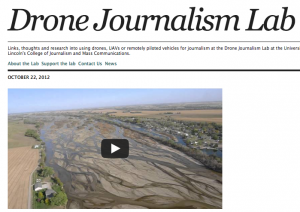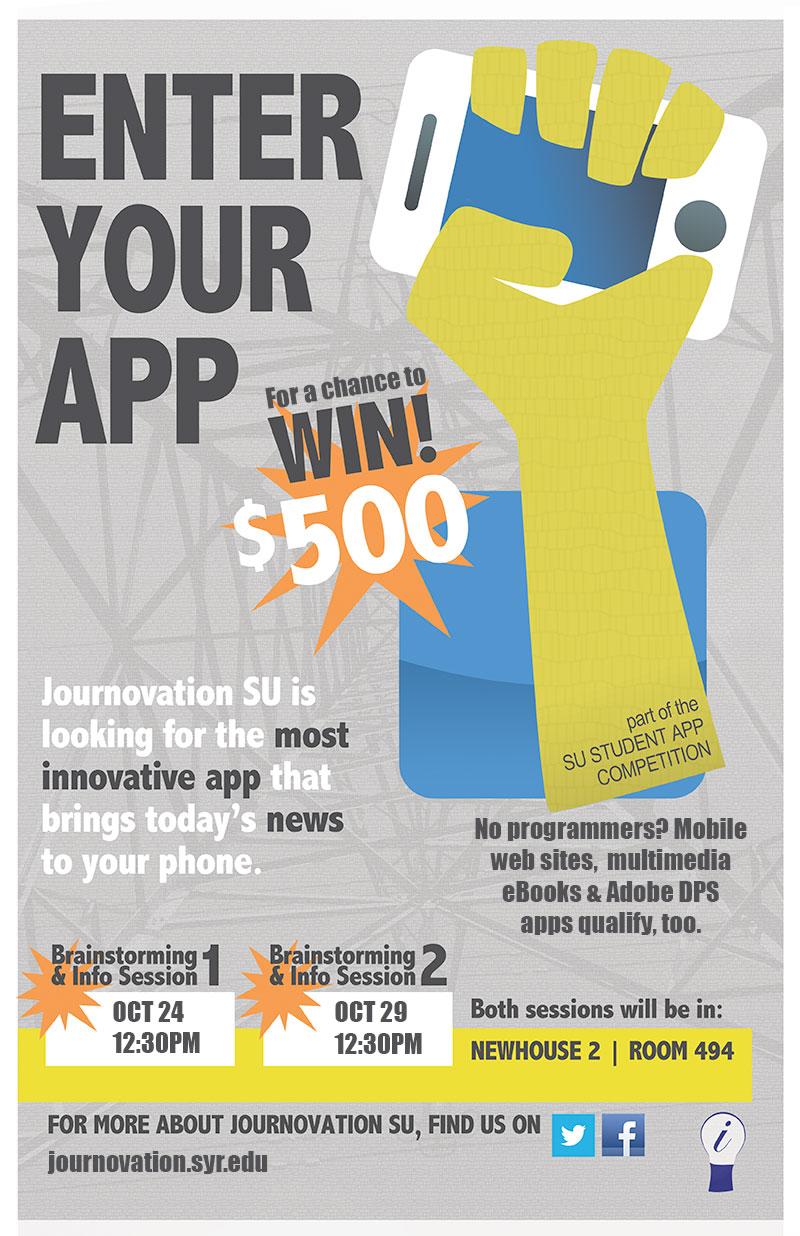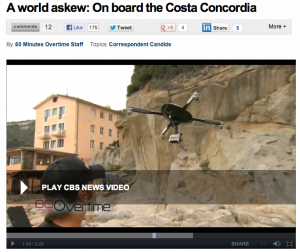Category Archive: Uncategorized
Next News Startup Survey
January 13, 2014

Dan Schultz joins Newshouse as First Visiting Programmer in Residence
August 23, 2013
As digital technology becomes increasingly important to media and journalism, so does knowing how to work with programmers and perform simple coding. You can only learn these skills by doing them, but where does a journalist or storyteller start?
Programmer-journalist Dan Schultz, who holds a degree from the MIT Media Lab, will help answer that question when he joins the Newhouse School as its first Visiting Programmer in Residence. Schultz, who spoke at Newhouse through the Digtial Edge Journalism series in the spring, comes straight from the Boston Globe, where he spent a year as a Knight-Mozilla OpenNews fellow. He is known for work on innovative projects such as Truth Goggles, which identifies and checks facts in news stories in real time, and NewsJack, which lets people rewrite and publish headlines as a form of digital satire.
At The Boston Globe, Schultz worked with the Globe Labs to employ new innovative ways to tell stories that go beyond text, photos and video. In A Night in the Life of a Cabbie, he connected detailed transcripts of a cab driver’s evening shift to a maps that shows the driver’s pay and expenses through the night. The interactive shows how difficult it is for cab drivers to make money when only a few companies can issue the expensive “medallions” that cab drivers must purchase in order to legally provide service. Interative features like this often require journalists to work closely with software developers, and even know a little code themselves. Programmers in residence like Schultz will give Newhouse students that critical experience.
“Dan will help Newhouse students take their ideas from the drawing board to working prototypes and more,” says Dean Lorraine Branham. “We also hope that he can provide technical assistance for students who have ideas for new products, but lack the programming and coding skills to make them happen.”
While Schultz’s background is in journalism and civic media, he will work with students from all majors. Newhouse Chair of Journalism Innovation Dan Pacheco will serve as Schultz’s host in the Newspaper and Online Journalism department. Students or faculty who are interested in working with Schultz should fill out this online form, or contact Pacheco at drpachec@syr.edu.
“We already have a list of student project ideas from faculty from across the school that can leverage Dan’s expertise,” says Pacheco. “But it will be really fun to see what students dream up that none of us have thought of yet. We know students have big digital ideas, but often get stuck when they want to do something that requires a little coding. Now we can help them cross that barrier and in the process learn that coding isn’t as mysterious or scary as they may think.”
Media coverage of Drone Day
January 24, 2013
The Syracuse local and campus media attended our Drone Day presentation on Jan. 23, watching our presentation about drones in journalism and the demonstration of our drone.
Here are links to the coverage.
Syracuse University journalism prof demos $300 camera drone | syracuse.com
Sneak Peek at Future of Flying Newsroom Drones : News : CNYcentral.com
Drones could buzz through your backyard : News : CNYcentral.com
Drone technology could soon be used in news – YNN, Your News Now
Win a Drone of Your Own!
January 22, 2013
Unmanned aerial vehicles equipped with cameras aren’t just for the military anymore. Thanks to new laws, they’re coming to newsrooms, TV and film studios — and even your own back yard. But just because a new technology can be used for something doesn’t mean that it necessarily should.
Help us chart a path for the responsible use of drones in news coverage and “civic media” that educates and informs, while also adhering to the FAA’s hobbyist guidelines for unmanned aircraft. Enter your ideas into this contest, and you may be the lucky winner of a drone of your very own!
There are two categories. One, best for Newhouse students, is to propose a news story that uses drone footage while adhering to the FAA’s hobbyist guidelines. The other, best for students who have some programming skills, is to use the A.R. Parrot 2.0 drone’s Software Development Kit (SDK) to create an iPhone or iPad app that enhances the drone’s newsgathering or documentary film operations.
Ready to enter? Fill out the form below.The deadline is midnight on February 23.
Only Syracuse University students may apply, but if you’re not an SU student we encourage you to partner with one. Good luck!
Drone Week: Examples of Drone Journalism
January 21, 2013
Drone Week continues here at Journovation. Remember, this Wednesday (Jan. 23) is the first of our Digital Edge Journalism Series. Starting at noon, Dan Pacheco will be talking about and demonstrating some of the ways drones can be used in journalism. We’ll also be flying our own drone and giving details about our Win a Drone of Your Own contest. (Don’t forget to sign up here. There’s food, too!).
One of the parts of our contest is coming up with a potential news story in which drones can be used. To get you thinking about stories you may want to pitch to us (or do in your own career), here are some examples of how drones are being used in the journalism world.

We start, as always, with the University of Nebraska-Lincoln’s Drone Journalism Lab. They used drones to cover the devastating droughts that hit the midwest in 2012. Professor Matt Waite has been at the forefront of the use and research of drones in journalism.
60 Minutes also used a drone to get some otherwise hard-to-get footage of the half-sunken Coasta Concordia, a passenger ship that ran aground in Tuscany.
In addition, the Occupy Wall Street Movement also used a drone – the same Parrot ARDrone that we’re using and giving away – to get a live feed of the 2011 protests.
Drone Week at Journovation!
January 17, 2013
With the first in our Digital Edge Journalism seminar scheduled for Wednesday (sign up here) focusing on drones in journalism, we’re turning the next few days into Drone Week. It’s like Shark Week, only … with Drones.
Over the next couple days, stay tuned to our site and to our Twitter feed for stories about how drones are being used in journalism, about the research that’s being done and about the ethical factors that go into the use of drones.
Reserve a spot in our News App brainstorming sessions
October 22, 2012
“App” sounds like a lot of hard development work for journalists, but it’s not. If you have good content there are some very easy, inexpensive ways to make it mobile-friendly that qualifies for the contest. Come to one of our two one-hour lunchtime info sessions (Oct. 24, Oct. 29) in Newhouse 2, 494 to learn about the following:
- Creating multimedia eBooks using Apple’s free iBooks Author tools.
- Creating a WordPress site with a mobile-friendly theme.
We’ll also have FOOD, so you can learn about how to make mobile apps and chow down at the same time. PLEASE RSVP to one of the two events on EventBrite here if you plan to attend so we can get enough food: http://journovationapp.
Hope to see you there!
Brainstorming sessions for News App contest
October 18, 2012
As we announced yesterday, we’re excited to be a part of the SU Student App Competition. We’re offering a $500 prize for the best student-designed news/journalism/civic media app.
 If you want more information on the contest, if you have an idea for an app but don’t know what to do next, or if you’re interested in this but don’t know where to start, we’re holding a couple of brainstorming sessions in the next two weeks:
If you want more information on the contest, if you have an idea for an app but don’t know what to do next, or if you’re interested in this but don’t know where to start, we’re holding a couple of brainstorming sessions in the next two weeks:
The first is Wednesday, Oct. 24, 12:30 p.m. The second is Monday, Oct. 29, 12:30 p.m.
Both sessions will be held in our office in Newhouse 2, Room 494. We’ll provide some food and the space to work on your idea and maybe find some collaborators.
If you have any questions, you can email Dan or Brian. Or follow us on Twitter.
Create the next great news app for a chance to win $500
October 16, 2012
 Any SU student who has a mobile app, or mobile-friendly web site, that has journalistic value should consider entering it into the SU Student App competition: http://idea.syr.
Any SU student who has a mobile app, or mobile-friendly web site, that has journalistic value should consider entering it into the SU Student App competition: http://idea.syr.- Innovation: How unique and creative is the app? Are there similar ideas out there? What makes the app better than others?
- Integrity: How robust is the app? Is the app just a functioning prototype or well-tested and ready for release?
- Impact: How useful is the app? Who will be using it? How will it change people’s lives and society?
Team Eligibility:
- At least one team member must be a full time SU student. Both graduate and undergraduate students are eligible. There is no limit on the number of team members.
- In order to receive an award, at least one team member must have the legal status to receive a monetary prize.
Requirements:
- Each competing team must develop an app: a set of software programs that runs on one of the following platforms:
- Web browsers e.g. Firefox (“web app”)
- Smart phones e.g. iPhone (“mobile app”)
- Tablet computers e.g. iPad (“tablet app”)
- Desktop operating systems e.g. Windows (“desktop app”)
- Programmable hardware platforms e.g. Arduino
- At least 50% of the code must be written by the team members (which must be either current Syracuse University students or 2012 graduates of Syracuse University), with the exception of the use of software libraries (e.g. APIs, SDKs) that are available to the public through licensing, which may be proprietary or non-proprietary.
- The majority (more than 50%) of the code must be written during the 2012-2013 academic year by the SU students on the team.
- Each team must demonstrate the functioning app at the Demo Alley section of Entrepalooza, on the day of the competition, after passing the first round of judging.
- Each team can submit only one app and each individual in the competition can belong to only one team.
- Each application must include all the required information on the application form. The entire source code is not part of the application. However, the source code of the app must be accessible to the judges and organizers upon request after the submission through the period of competition.
- Each team must be the legal owner of the entire software submitted to the competition.
- A submission may be disqualified if it fails to comply with any of the requirements above.
Repost.us: a New Model for Networked Journalism
October 3, 2012
My favorite innovations are the ones that are so easy and obvious that you hit yourself in the head every morning asking yourself, “why didn’t I think of that?” Repost.us is in that camp.
Repost.Us’ founder John Pettitt, also co-founder of e-commerce company Cybersource and career networking company Beyond.com, calls Repost.Us “Syndication in the 21st century.” He explains it this way: “If you see an article and want to repost it on another site, you have to find a human being and find out if you can do it. And that’s so last-century … there’s a better way. The video world has the embed. Why can’t you embed an entire article?”
[youtube]https://www.youtube.com/watch?v=lj6l-hHCh6I[/youtube]
He has a point. A huge part of the blogosphere consists of sloppy rewrites and citations of other peoples’ content, usually (but not always) followed by a link to the full story on the originating site. These links are helpful to the content creators because it helps their SEO in Google, and also gets them a few more ad impressions for people who click through, but the click-through to those links is not terribly high.
As a result, a whole generation of content companies have emerged in recent years to aggregate, curate and make money off content that they simply found, but didn’t pay to create. For investigative journalism this is particularly problematic because the cost of those stories is never covered by the ads to the few readers who click into the original story.
This is where RepostUs shines. When you go to a site that carries the RepostUs code and try to copy a chunk of text, you see a friendly popup telling you that you can embed the entire article — a prospect that is actually better and easier than simply including a quote in your own post. You copy the embed code just like in YouTube, plop it into your blogging software and the entire contents of the article are included on your own site with branding of the originating site.
But the real power is that it also carries the advertising and analytics code of the originating site. This is where I smack myself on the head every time. Of course! This is a total game-changer for the hard-working journalist or blogger in many ways. (I know that Jeff Jarvis at CUNY, who exitedly told me about RepostUs the minute I saw him at the Online News Association conference, agrees).
- First, it provides a financial incentive for them to encourage people to “rip off” their content. Why? Because it increases the audience for their advertisers.
- Second, it also increases the total traffic to their site, because now they’re getting credit for the other places where their article appears.
- Third — and this is the most interesting part — it redefines the entire nature of brands online. If embedding articles becomes more common than linking to them (which is not hard to imagine, given the prevalence of embedded YouTube videos), what is a site anymore? And could you even go so far as to say “who cares about your web site?” What matters is that people are reading your content, and you’re getting credit and ad revenue from it. Does it really matter where people are reading it?
I’m so excited about RepostUs that I’ve enabled it on this site, so if you want to see how it works you can do it right now. Copy any chunk of text in this article and see what happens, then embed the content into your own site. You can see examples where I’ve done this on my personal blog at http://futureforecast.com/blog.
Now if you excuse me, I need to go repost this article on a dozen of my other sites!
-Dan Pacheco, Chair of Journalism Innovation, S.I. Newhouse School of Public Communications
